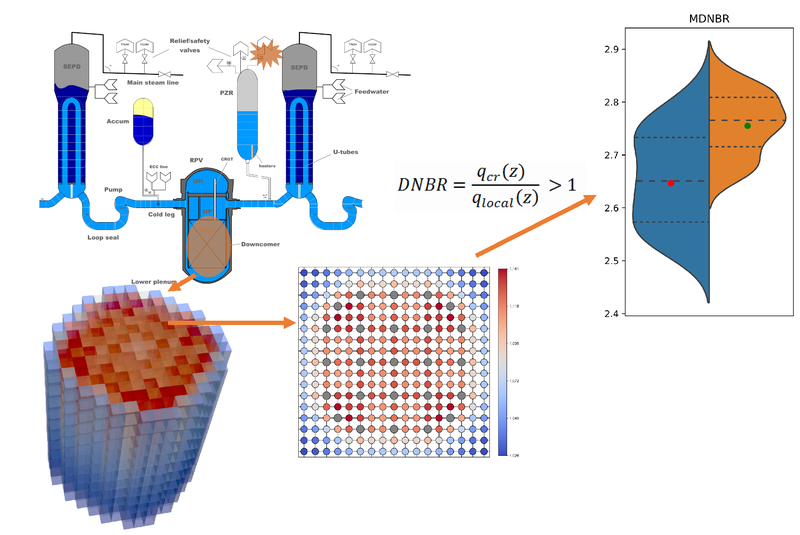Max Casamor defends his thesis on the safety analysis for nuclear reactors.
Nov 11, 2022
Max Casamor defended his thesis co-supervised by professors Jordi Freixa and Francesc Reventós on October 10 at the Escola Técnica Superior d'Engineria Industrial de Barcelona. Entitled "Evaluation of TH Multi-Scale Coupling Methods in BEPU Analysis", the thesis presents the application of advanced methodologies in safety analysis for nuclear reactors.
The combined use of thermal-hydraulics system with sub-channel codes (TH-TH coupling) in transient analysis provides an integrated tool with the capability of modelling in detail both the core thermal-hydraulic conditions and the system behaviour. Different code coupling methods are often used in the nuclear industry to provide accuracy to the calculations while maintaining a sufficient degree of usage. In some cases, and for specific scenarios, the coupling method can be simplified to the off-line transfer of the the boundary conditions from plant models run by system codes to sub-channel codes (off-line coupling).
The off-line coupling approach has been considered valid to evaluate the safety margins for limiting parameters such as the minimum departure from nucleate boiling ratio, which relates the local power with the critical heat flux. The off-line coupling is fast and sufficiently accurate in most situations, however, boundary conditions at the inlet and at the outlet of both solutions will present miss-matchings. In order to overcome the inconsistencies between system and sub-channel codes, advanced on-line coupling methods may be applied (e. g. semi-implicit coupling). These are methods that imply coherent boundary conditions between codes in all domain and are significantly more complex in mathematical terms. The selection of an appropriate coupling method between system and sub-channel codes is crucial. Recent sensitivity studies performed in sub-channel codes have shown a strong influence of the boundary condition's uncertainty to the major figure of merit.
The present study aims to evaluate the implications of the coupling methods in safety analysis evaluations in two transients with strong system effects. For this purpose, CTF (a sub-channel code) and RELAP5 (system code) are coupled using two coupling techniques: the off-line coupling, where the boundary conditions are obtained from the RELAP5 model and imposed by table to CTF, and the semi-implicit coupling method, which has been applied to couple CTF and RELAP5, implementing the semi-implicit coupling methodology developed by Weaver in 2002.
The selected cases for the study are a complete loss of forced flow and a pressurizer relief valve opening. The models used are, on one hand, a RELAP5 plant model that consists of a full plant model of a generic Westinghouse 3-loop nuclear power plant. On the other hand, a hybrid assembly sub-channel CTF core model has been developed using the same reference data as the RELAP5 model.
In recent years, the application of Best Estimate Plus Uncertainty (BEPU) calculations, has gained importance in the scientific community. This method, far from adding conservatism by forcing non-physical conditions to the calculations, tries to take the uncertainties of the calculations into the process. The BEPU method used in the present study is the GRS BEPU method, which implements Wilks' method using order statistics.
BEPU analysis can be considered an additional tool for coupling methods comparisons. Results show that base cases and sensitivity analysis present good agreement between the coupling methods with some minor discrepancies. For the first case, the Spearman's rank correlation coefficients and distributions of the BEPU analysis present similar results for the two approaches. On the contrary, the second case shows differences in the evaluation of the figures of merit, which can be explained and correlated to the boundary conditions deviations between codes. This suggests that non-imposed boundary condition values for the off-line coupling method is an important issue to take into account when applying this type of method for system-dependent transients that are extended in time.

Share: